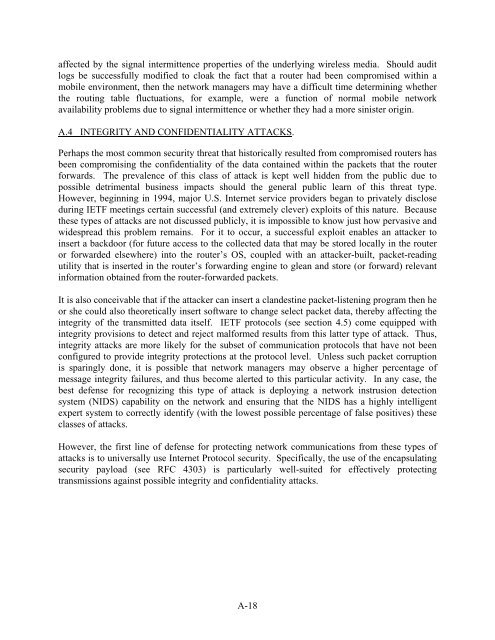Local Area Networks (LANs) in Aircraft - FTP Directory Listing - FAA
Local Area Networks (LANs) in Aircraft - FTP Directory Listing - FAA
Local Area Networks (LANs) in Aircraft - FTP Directory Listing - FAA
Create successful ePaper yourself
Turn your PDF publications into a flip-book with our unique Google optimized e-Paper software.
affected by the signal <strong>in</strong>termittence properties of the underly<strong>in</strong>g wireless media. Should audit<br />
logs be successfully modified to cloak the fact that a router had been compromised with<strong>in</strong> a<br />
mobile environment, then the network managers may have a difficult time determ<strong>in</strong><strong>in</strong>g whether<br />
the rout<strong>in</strong>g table fluctuations, for example, were a function of normal mobile network<br />
availability problems due to signal <strong>in</strong>termittence or whether they had a more s<strong>in</strong>ister orig<strong>in</strong>.<br />
A.4 INTEGRITY AND CONFIDENTIALITY ATTACKS.<br />
Perhaps the most common security threat that historically resulted from compromised routers has<br />
been compromis<strong>in</strong>g the confidentiality of the data conta<strong>in</strong>ed with<strong>in</strong> the packets that the router<br />
forwards. The prevalence of this class of attack is kept well hidden from the public due to<br />
possible detrimental bus<strong>in</strong>ess impacts should the general public learn of this threat type.<br />
However, beg<strong>in</strong>n<strong>in</strong>g <strong>in</strong> 1994, major U.S. Internet service providers began to privately disclose<br />
dur<strong>in</strong>g IETF meet<strong>in</strong>gs certa<strong>in</strong> successful (and extremely clever) exploits of this nature. Because<br />
these types of attacks are not discussed publicly, it is impossible to know just how pervasive and<br />
widespread this problem rema<strong>in</strong>s. For it to occur, a successful exploit enables an attacker to<br />
<strong>in</strong>sert a backdoor (for future access to the collected data that may be stored locally <strong>in</strong> the router<br />
or forwarded elsewhere) <strong>in</strong>to the router’s OS, coupled with an attacker-built, packet-read<strong>in</strong>g<br />
utility that is <strong>in</strong>serted <strong>in</strong> the router’s forward<strong>in</strong>g eng<strong>in</strong>e to glean and store (or forward) relevant<br />
<strong>in</strong>formation obta<strong>in</strong>ed from the router-forwarded packets.<br />
It is also conceivable that if the attacker can <strong>in</strong>sert a clandest<strong>in</strong>e packet-listen<strong>in</strong>g program then he<br />
or she could also theoretically <strong>in</strong>sert software to change select packet data, thereby affect<strong>in</strong>g the<br />
<strong>in</strong>tegrity of the transmitted data itself. IETF protocols (see section 4.5) come equipped with<br />
<strong>in</strong>tegrity provisions to detect and reject malformed results from this latter type of attack. Thus,<br />
<strong>in</strong>tegrity attacks are more likely for the subset of communication protocols that have not been<br />
configured to provide <strong>in</strong>tegrity protections at the protocol level. Unless such packet corruption<br />
is spar<strong>in</strong>gly done, it is possible that network managers may observe a higher percentage of<br />
message <strong>in</strong>tegrity failures, and thus become alerted to this particular activity. In any case, the<br />
best defense for recogniz<strong>in</strong>g this type of attack is deploy<strong>in</strong>g a network <strong>in</strong>strusion detection<br />
system (NIDS) capability on the network and ensur<strong>in</strong>g that the NIDS has a highly <strong>in</strong>telligent<br />
expert system to correctly identify (with the lowest possible percentage of false positives) these<br />
classes of attacks.<br />
However, the first l<strong>in</strong>e of defense for protect<strong>in</strong>g network communications from these types of<br />
attacks is to universally use Internet Protocol security. Specifically, the use of the encapsulat<strong>in</strong>g<br />
security payload (see RFC 4303) is particularly well-suited for effectively protect<strong>in</strong>g<br />
transmissions aga<strong>in</strong>st possible <strong>in</strong>tegrity and confidentiality attacks.<br />
A-18
















